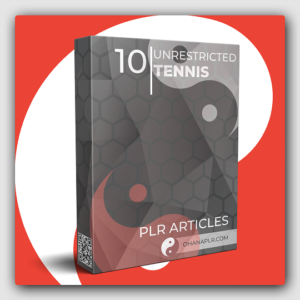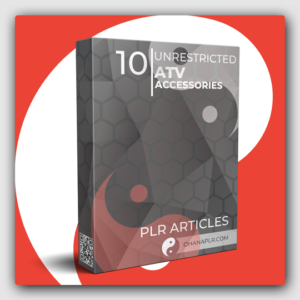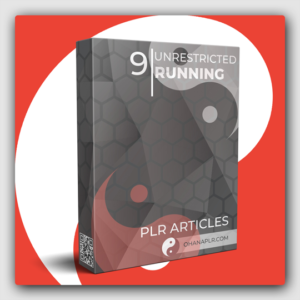Full Description
10 Unrestricted Tennis PLR Articles
In this PLR Article Pack, You will get 10 Unrestricted Tennis PLR Articles with Private Label Rights to assist you in dominating the Sports market.
These Information PLR articles are available in a Zip folder containing the Text file format product, and its license.
It can be instantly downloaded after the purchase is confirmed.
How Can You Use This PLR Article Pack?
- For Internet Marketing, Affiliate Marketing
- Reselling
- List Building
- Blogging
What Can You Do With This Information PLR Article Pack?
- Convert it into an E-course and resell it
- Use it on your blog
- Create an autoresponder series.
- You may use it to build your email list
- covert it into any kind of digital or physical info product which you can resell with a Personal Use Only License (PUR) only.
10 Unrestricted Tennis PLR Articles
The Titles in This Product are:
- Chop, Half Volley, And Court Position
- General Tennis Psychology
- Grip, Footwork, And Strokes In Tennis
- Service-the Opening Gun Of Tennis
- The Drive In Tennis
- The Fundamentals Of Tennis
- The Psychology Of Match Play In Tennis
- The Psychology Of Physical Fitness
- The Psychology Of Singles And Doubles In Tennis
- The Volley And Overhead Smash
Here is a Sample Snippet of what you can expect inside this package
Chop, Half Volley, And Court Position.
Chop stroke.
————In Tennis, a chop stroke is a shot where the angle towards the player and behind the racquet, made by the line of flight of the ball, and the racquet travelling down across it, is greater than 45 degrees and may be 90 degrees. The racquet face passes slightly outside the ball and down the side, chopping it, as a man chops wood. The spin and curve is from right to left. It is made with a stiff wrist.
The slice shot merely reduced the angle mentioned from 45 degrees down to a very small one. The racquet face passes either inside or outside the ball, according to direction desired, while the stroke is mainly a wrist twist or slap. This slap imparts a decided skidding break to the ball, while a chop “drags” the ball off the ground without break.
The rules of footwork for both these shots should be the same as the drive, but because both are made with a short swing and more wrist play, without the need of weight, the rules of footwork may be more safely discarded and body position not so carefully considered.
Both these shots are essentially defensive, and are labour-saving devices when your opponent is on the baseline. A chop or slice is very hard to drive, and will break up any driving game.
It is not a shot to use against a volley, as it is too slow to pass and too high to cause any worry. It should be used to drop short, soft shots at the feet of the net man as he comes in. Do not strive to pass a net man with a chop or slice, except through a big opening.
The drop-shot is a very soft, sharply-angled chop stroke, played wholly with the wrist. It should drop within 3 to 5 feet of the net to be of any use. The racquet face passes around the outside of the ball and under it with a distinct “wrist turn.” Do not swing the racquet from the shoulder in making a drop shot. The drop shot has no relation to a stop-volley. The drop shot is all wrist. The stop-volley has no wrist at all.
Use all your wrist shots, chop, slice, and drop, merely as an auxilliary to your orthodox game. They are intended to upset your opponent’s game through the varied spin on the ball.
The half volley.
—————-This shot requires more perfect timing, eyesight, and racquet work than any other, since its margin of safety is smallest and its manifold chances of mishaps numberless.
It is a pick-up. The ball meets the ground and racquet face at nearly the same moment, the ball bouncing off the ground, on the strings. This shot is a stiff-wrist, short swing, like a volley with no follow through. The racquet face travels along the ground with a slight tilt over the ball and towards the net, thus holding the ball low; the shot, like all others in tennis, should travel across the racquet face, along the short strings. The racquet face should always be slightly outside the ball.
The half volley is essentially a defensive stroke, since it should only be made as a last resort, when caught out of position by your opponent’s shot. It is a desperate attempt to extricate yourself from a dangerous position without retreating. never deliberately half volley.
Court position.
—————A tennis court is 39 feet long from baseline to net. There are only two places in a tennis court that a tennis player should be to await the ball.
1. About 3 feet behind the baseline near the middle of the court, or
2. About 6 to 8 feet back from the net and almost opposite the ball.
The first is the place for all baseline players. The second is the net position.
If you are drawn out of these positions by a shot which you must return, do not remain at the point where you struck the ball, but attain one of the two positions mentioned as rapidly as possible.
The distance from the baseline to about 10, feet from the net may be considered as “no-man’s-land” or “the blank.” Never linger there, since a deep shot will catch you at your feet. After making your shot from the blank, as you must often do, retreat behind the baseline to await the return, so you may again come forward to meet the ball. If you are drawn in short and cannot retreat safely, continue all the way to the net position.
Never stand and watch your shot, for to do so simply means you are out of position for your next stroke. Strive to attain a position so that you always arrive at the spot the ball is going to before it actually arrives. Do your hard running while the ball is in the air, so you will not be hurried in your stroke after it bounces.
It is in learning to do this that natural anticipation plays a big role. Some players instinctively know where the next return is going and take position accordingly, while others will never sense it. It is to the latter class that I urge court position, and recommend always coming in from behind the baseline to meet the ball, since it is much easier to run forward than back.
Should you be caught at the net, with a short shot to your opponent, do not stand still and let him pass you at will, as he can easily do. Pick out the side where you think he will hit, and jump to, it suddenly as he swings. If you guess right, you win the point. If you are wrong, you are no worse off, since he would have beaten you anyway with his shot.
Your position should always strive to be such that you can cover the greatest possible area of court without sacrificing safety, since the straight shot is the surest, most dangerous, and must be covered. It is merely a question of how much more court than that immediately in front of the ball may be guarded.
A well-grounded knowledge of court position saves many points, to say nothing of much breath expended in long runs after hopeless shots.
License Details:
[YES] You get all the articles with private label rights
[YES] You can brand the articles with your name
[YES] You can edit the articles
[YES] You can use the articles to create an autoresponder email series
[YES] You can use articles as web content
[YES] You can use articles as content for your ebooks
[YES] You can use articles as content for your reports
[YES] You can use articles as content for your off-line publications
[YES] You can use translate all articles to any language you want
[YES] You can sell the articles
[YES] You can sell them with resale rights
[YES] You can sell them with master resale rights
[YES] You can sell them with private label rights
[YES] You can add them to your membership sites
[YES] You can sell them on auction sites
[YES] You can use them to build your list
[YES] You can give them as a bonus
[YES] You can package them and sell the packages in any way you want
[YES] You can start a membership site and deliver articles to your members
[NO] You cannot give them away for free under any circumstances
Join Our Family
Members of the Ohana Family are entitled to loads of perks including downloading this product at no additional cost.






 Protected by Patchstack
Protected by Patchstack
Reviews